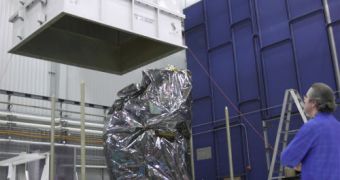Yesterday, January 11, a new NASA Earth-observing satellite has been delivered to the Vandenberg Air Force Base (VAFB), in California, in preparation for its upcoming launch. The mission is scheduled to take to the skies on February 23.
The spacecraft, dubbed Glory, was designed, produced and tested at the Dulles, Virginia-based Orbital Sciences Corporation test facility. The mission was developed by NASA as part of its program to observe our planet in minute detail.
Glory will be tasked with determining how airborne particles called aerosols are influencing Earth's climate, as well as the global warming trend Earth is currently experiencing. The spacecraft will also need to analyze the role that the Sun plays in these phenomena.
Once launched and commissioned, it will join the A-Train (Afternoon Constellation) of polar-orbiting satellites, which contain spacecraft that keep track of a variety of planetary and atmospheric parameters, such as soil moisture, ocean salinity, clouds, rains and so on.
“The scientific knowledge gained from Glory will have a significant impact on our understanding of natural and human influences on climate,” explains Glory program scientist Hal Maring, who is based at the NASA Headquarters, in Washington, DC.
The Aerosol Polarimetry Sensor (APS) and the Total Irradiance Monitor (TIM) will be the two main components of Glory's advanced instrument suite. The former will measure aerosol concentrations in the atmosphere, whereas the other will be pointed at the Sun.
TIM's job will be to measure total solar irradiance, thus continuing a 32-year, non-stop data collection effort in this direction. NASA is the largest source of data concerning solar irradiance in the world.
Glory will take to the sky on February 23, from the VAFB Space Launch Complex 576-E. Take-off is scheduled to occur at 2:09 am PST (1009 GMT). The spacecraft will be ferried to orbit aboard an OSC-built Taurus XL 3110 four-stage delivery system.
“On January 18, Stage 0 of Orbital’s Taurus XL 3110 four-stage rocket will be moved to the launch pad and hoisted into position. Stages 1, 2 and 3 will join stage 0 on the pad on Jan 25,” NASA announces.
“The Glory spacecraft will be enclosed in the Taurus XL payload fairing on Feb. 4-5 and transported to the launch pad to be mated to the third stage of the rocket the following day. Once the spacecraft is integrated with stages 1, 2, and 3, the entire unit will be rotated to vertical and hoisted atop stage 0 on Feb. 15,” the same statement adds.
The Greenbelt, Maryland-based NASA Goddard Space Flight Center (GSFC) will manage Glory for the space agency's Science Mission Directorate, in Washington, DC.

 14 DAY TRIAL //
14 DAY TRIAL //